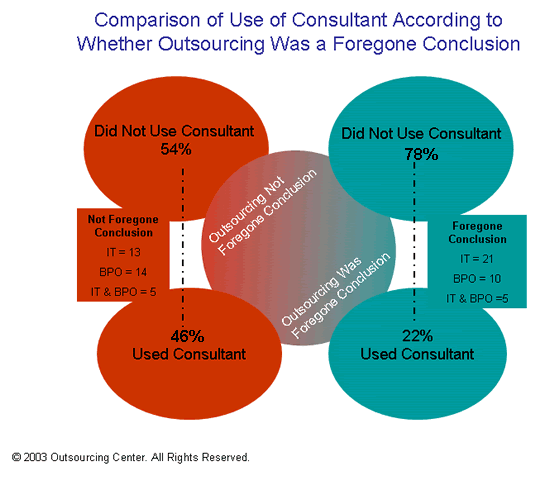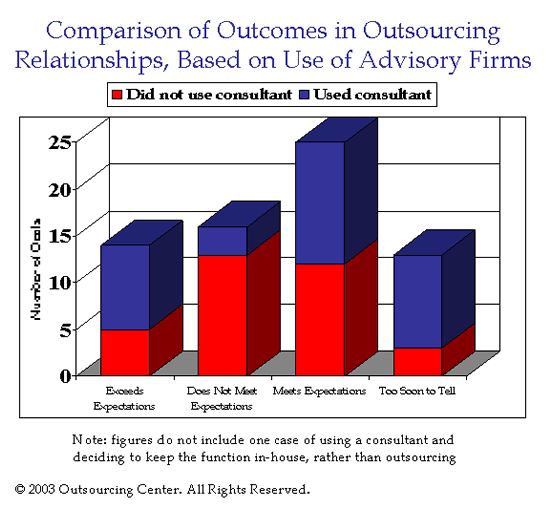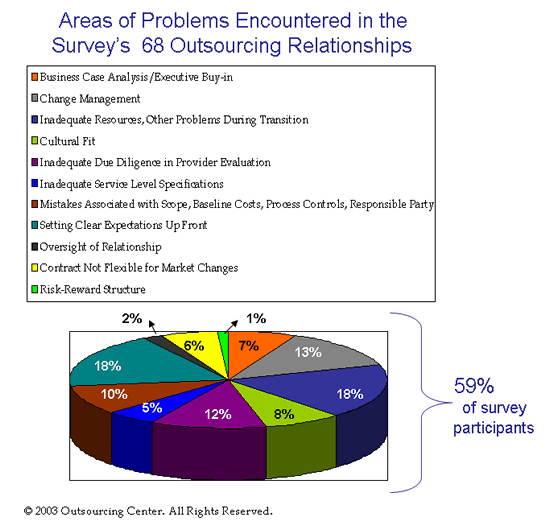There’s a growing trend in the outsourcing community: fewer buyers are retaining advisory firms with outsourcing expertise. What is most troublesome is this decrease is occurring at the same time when the complexities in today’s outsourcing decision-making processes are increasing. A key finding is that the actual outcomes of relationships established via the decision-making approach in this trend differ dramatically from the outcomes anticipated by the executives deploying it.
Outsourcing Center conducted executive interviews of 68 leading organizations (within 11 industries and the public sector) throughout the U.S. and Europe between December 2002 and May 2003 regarding their most recent outsourcing decision-making processes. The Center determined the trend has three primary drivers:
- Cost: Bottom-line costs top boardroom agendas and, in many instances, companies historically have paid a high tab as some consulting engagements ran out of control
- Management: In some instances, the use of advisory firms has been judged as a “crutch” or evidence of management ineptitude
- Experience: A pool of corporate executives with prior experience in outsourcing initiatives (“veterans”) now exists.
Until recently, most outsourcing relationships with successful outcomes originated in a variety of consultant- and analyst-aided decision processes. Until the late 1990’s, there was no other pool from which to draw the insights necessary to craft a highly successful outsourcing arrangement. But now, the growing pool of veterans has facilitated the growth of this new trend in outsourcing decision-making.
Study Findings
Finding #1: Key Decision Component
As illustrated in Figure 1, the decision to use advisory firms in outsourcing initiatives begins with whether or not outsourcing is a foregone conclusion.

Buyers who retained advisory firms for their outsourcing decisions (78% and 22% in Figure 1 above), stated their reasons for seeking outside expertise were:
- Assessment of risks
- Business case analysis to achieve board and other stakeholders’ buy-in
- Cultural fit analysis
- Objective exploration of opportunities for creating and sustaining value
- Evaluation of a sole-source arrangement.
Finding #2: Use of Veterans
In 22 of the 68 organizations participating in the study, there are in-house CXO executives who are outsourcing veterans. According to the study, buyer organizations with resident outsourcing veterans are more likely not to use advisory firms in the outsourcing decision-making process. The primary reason stated for a preference of in-house veterans over advisory firms was that the planned outsourcing initiative was not considered complex. Such “simple” initiatives usually involve one outsourced function and revolve around the following drivers, easily achieved through traditional outsourcing strategies:
- Reduce operational costs
- Gain access to capital or IT resources
- Improve productivity and service levels
- Change to a variable (or fixed) cost structure
- Decrease time to market.
In such instances, outsourcing was usually a foregone conclusion. The study found that, where outsourcing was a foregone conclusion:
- 2% chose not to use an advisory firm because there were only a limited number of service providers with the required expertise or resources
- 11% did not use an advisory firm because the buyer had a prior relationship with the preferred service provider
- 87% chose not to use an advisory firm because the buyer has one or more in-house outsourcing veterans.
Analysis of the Veterans Trend
A key finding of the study reveals that buyers perceive in-house veteran experience to be not only a cost-effective replacement of advisory firms but, also, of similar value in achieving successful outcomes. The study, however, finds the opposite to be reality, as illustrated in Figure 2.

The leap in numbers for outcomes that do not meet expectations and where the decision-making approach did not rely on advisory firms points to a danger zone for buyer organizations using this approach.
The veterans approach is not unlike a nation’s commander-in-chief making a decision as to whether or not to go to war (and how), based simply on the knowledge of a military veteran. Although there is much that is common to the hands-on experience of in-house outsourcing “veterans” and advisory firms’ consultants, a veteran’s knowledge is similar to the portion of an iceberg that is visible above the water’s surface (with potential dangers lurking because of the not-visible portion beneath the surface).
Consider the following in assessing a veteran’s role in a prior outsourcing initiative. At what level was the veteran involved in crucial aspects that would impact the success of a relationship? Consider how these parameters will impact knowledge for a current decision. Was the veteran a strategic planner or just following orders; a decision-maker or an apprentice?
What was the veteran’s role in assessing risks of the “battle plan?” Since an army can converge from different directions (and an outsourcing transition and implementation must be flexible for changes coming from many directions), how effective were the veteran’s judgments as to what was significant in developing the best plan? Was the veteran a key resource in achieving success as the troops’ stamina dwindled or communications were lacking and they became demoralized? What was the veteran’s role when the going got tough as circumstances changed; how did the veteran help to ensure the outsourcing plan would flourish?
Just as a commander would not put an entire nation and economy at risk on the advice of a veteran’s experience in one, or even several, conflicts, a buyer organization’s executives must consider whether an in-house outsourcing veteran’s experience and knowledge is relevant and comprehensive for the outsourcing decision at hand.
Is veteran IT experience, for example, applicable to a robust BPO initiative? Is the veteran’s experience relevant to offshoring? Each outsourcing initiative is a business case on its own. While there are some commonalities, each requires a different set of knowledge. How have the marketplace, technology, and outsourcing best practices changed since the veteran’s experience? In-house veterans are not exposed to the market on a daily basis, but advisory firms are.
Recommendations for Outsourcing Advice
In-the-trenches veteran experience is highly valued; indeed, some advisory firms blend veterans and consulting expertise into their advisory solutions so the buyer gets the best of both worlds. Nevertheless, using solely an in-house veteran approach can result in costly mistakes. Areas of problems encountered by participants in this study are illustrated in Figure 3.

The decision to use an in-house veteran or an advisory firm should be based on whether the veteran is able to structure an outsourcing arrangement that produces the desired objectives and also mitigates the high incidence of mistakes illustrated in Figure 3.
Outsourcing Center recommends buyers consider the following criteria when determining an approach to advice for outsourcing:
- Advice should encompass robust knowledge of the buyer’s industry, best practices in the function to be outsourced; insight into the service provider marketplace; comprehensive experience, and analytic skills
- The services of an advisory firm should compliment the buyer organization’s existing decision-making process
- Advice should challenge the buyer organization’s existing assumptions
- Advice should evaluate the proposed initiative holistically within several alternative scenarios
- Advice should be based on proven, best-practice decision frameworks for both accomplishing objectives and creating ongoing value
- An advisory firm’s services should revolve around a methodology that includes an executable project plan for structuring the work and yet be flexible for the buyer organization’s unique situation.
Lessons from the Outsourcing Journal:
- Where the buyer perceives objectives as being easily achieved and outsourcing is a foregone conclusion, in-house veterans and advisory firms are perceived to be of similar value.
- Where the buyer perceives objectives as being more strategic and complex, there is a higher incidence of using advisory firms in the decision-making process.
- It is not difficult to get into an outsourcing relationship, but its staying power and continual return on investment over the long term is not so easy to achieve. Because of its robust knowledge, comprehensive experience, and insight, the advisory firm approach demonstrates superiority over the in-house veterans approach.
About the Author: Ben Trowbridge is an accomplished Outsourcing Consultant with extensive experience in outsourcing and managed services. As a former EY Partner and CEO of Alsbridge, he built successful practices in Transformational Outsourcing, Managed services provider, strategic sourcing, BPO, Cybersecurity Managed Services, and IT Outsourcing. Throughout his career, Ben has advised a broad range of clients on outsourcing and global business services strategy and transactions. As the current CEO of the Outsourcing Center, he provides invaluable insights and guidance to buyers and managed services executives. Contact him at [email protected].